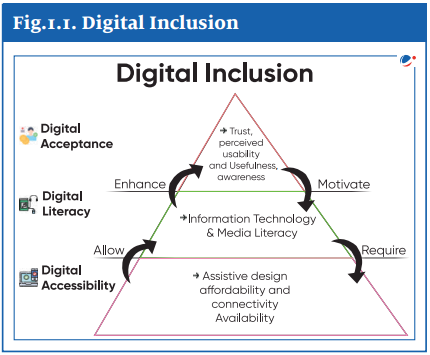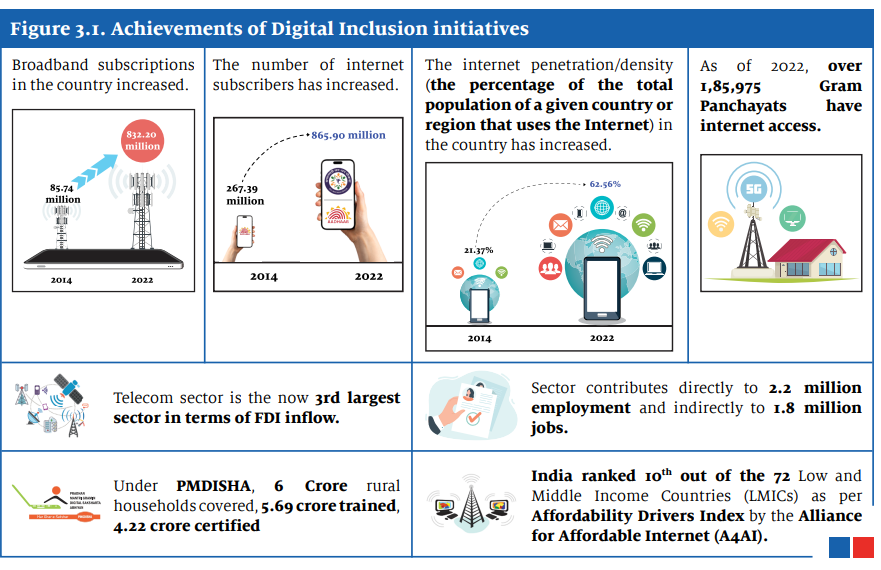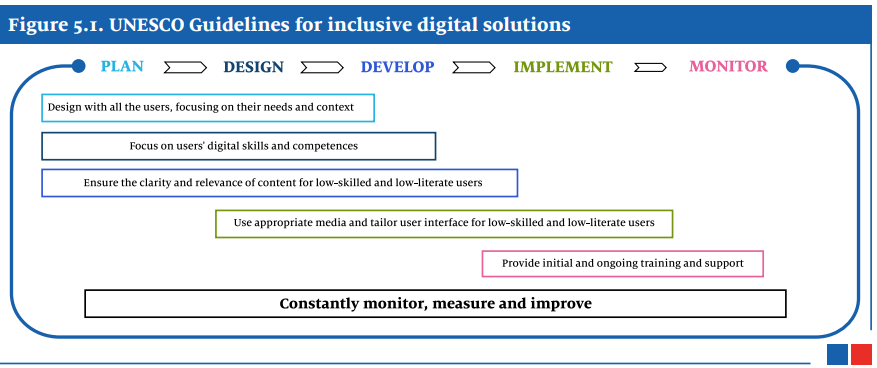Introduction
In the rapidly evolving digital era, the concept of digital inclusion has become a pivotal lens through which we examine the equitable distribution of technological benefits. Beyond mere access to digital tools, digital inclusion emphasizes the importance of fostering digital literacy, skills, and a supportive environment. India too has achieved remarkable strides in its digital inclusion landscape and now has the second-largest telecom market in the world in terms of telecom subscribers. However, challenges persist, ranging from geographical disparities to socio-economic factors that hinder universal access. Looking ahead, India needs collaborative efforts to ensure that the digital revolution extends its benefits comprehensively.
What does digital inclusion mean?
Digital inclusion is defined by the United Nations (UN) as “equitable, meaningful, and safe access to use, lead, and design of digital technologies, services, and associated opportunities for everyone, everywhere”.
- Digital inclusion is enabled by human rights-based, intersectional, whole-of-society and multi-stakeholder approaches and actions. In that, it takes into account various barriers that individuals face when accessing and experiencing digital technologies.
- For e.g. - rural populations face geographical and physical barriers in connecting online and lack of relevant skills create barrier for older persons to access technologies.
- Digital inclusion therefore aims to dismantle existing structural social inequalities and enhance well-being for all.
In sum, critical dimensions of digital inclusion are recognised as Digital Accessibility, Digital Literacy, and Digital Acceptance.
- Digital accessibility is the extent to which digital devices and infrastructure are available and navigable to everyone in order to provide a level playing ground for all.
- Digital literacy is the ability to access, manage, understand, integrate, communicate, evaluate and create information safely and appropriately through digital technologies.
- Digital acceptance is the understanding of and attitudes regarding the usage of digital technology.

Box 1.1. Digital Equality v/s Digital Equity
Digital equality means treating everyone the same. For example, handing out the same model of tech device to each student in a class, that’s digital equality. Digital equity, however, allows and sometimes promotes fairness through treating people differently depending on need, or prioritising one group of people over another such as in positive discrimination (for example, subsidies for persons with disabilities). |
What are the positive outcomes of achieving digital inclusion?
Achieving digital inclusion brings several positive outcomes for individuals, communities, and society as a whole. Some of these include:
- Economic Empowerment: Digital Inclusion fosters economic empowerment by expanding access to online job markets, promoting digital entrepreneurship, and enhancing livelihoods.
- For instance, platforms such as National career service and Naukri.com and various E-Commerce Platforms contributes to economic growth and reduce disparities.
- Accessibility to Education: Massive Open Online Courses, educational YouTube channels facilitate e-learning, access to educational resources, and develop skills necessary for the job market. It also connects students to global educational platforms, broadening their perspectives.
- Community Building and Cross-Cultural Communication: Social Media Platforms, Online Gaming Communities and other content sharing platforms enhance social interactions and enables cross-cultural connections by breaking down geographical boundaries and promoting diverse perspectives.
- Healthcare Access: It supports remote healthcare services, allowing individuals to access medical consultations and information through telemedicine. At the same time, wearable technology and health monitoring apps empower individuals to proactively manage their health.
- Government Efficiency and Civic Engagement: It ensures access to governmental information, fostering informed citizenry, and streamlining civic engagement thereby increasing efficiency.
- For example, MyGov platform in India promote citizen participation in governance.
- Financial inclusion: UPI, Mobile Wallets, Digital Lending Platforms enhances financial empowerment of unbanked and underserved populations. It promotes economic stability and resilience among individuals and communities.
- Continuous Learning and Digital Literacy: Digital inclusion promotes continuous learning by providing access to online courses and resources. It encourages the development of digital literacy skills crucial for navigating the evolving digital landscape.
- Entrepreneurial Innovation: Digital inclusion has been a catalyst for entrepreneurial innovation providing individuals and businesses with the tools and resources to create, innovate, and scale their operations.
- Various Agri-Tech Startups, EdTech Platforms and Fintech Innovations mushrooming in recent times are testament to this.
Box 2.1. MSMEs and Digital Inclusion
In India, prior to COVID pandemic, majority of MSMEs were in the offline tier i.e. had no internet connectivity, may or may not have a computer and do not use social media for business purposes. However, it is seen that the number of businesses engaging with digital technologies have increased after the pandemic(CRISIL survey). The survey reports that over 47% micro-enterprises and 53% small enterprises have adopted online platforms for digital selling.
Benefits of Digitalisation for MSMEs:
Major Challenges faced by MSMEs in digitalising
|
What measures has the government implemented to foster digital inclusivity, and what successes have been realized as a result?
Table 3.1. Government initiatives to foster digital inclusion | |
For Digital Connectivity |
|
For Digital Affordability |
|
For Digital Literacy: |
|
For Digital financial inclusion: |
|
Digital Initiatives for MSMEs |
|
Achievements:
As a result of above initiatives, India has made considerable progress over the years:

What are the current barriers to digital inclusion in India?
At macro level, the performance of the country is very impressive. However, at micro and disaggregated levels there appear to be variations in the usage of the internet and broadband services across different sections of society and geographies. This has been highlighted through the following gaps that exist in the country:
Fig 4.1. Critical gaps in India | |||
Digital divide : It refers to “the gap between individuals, households, businesses and geographic areas at different socio-economic levels with regard to both their opportunities to access ICTs and to their use of the internet.
| Rural-Urban Gap: It exists in terms of Internet Tele-density and Digital Literacy.
|
| |
Gender Gap:
| Interstate disparities
The internet usage and density differ significantly from one state to another. The internet density is highest in Delhi, lowest in Bihar.
| ||
Major factors responsible for above gaps are:
- Infrastructureand Access: In many regions, especially in rural or economically disadvantaged areas, there is a lack of basic ICT infrastructure such as reliable internet connectivity, electricity, and affordable devices. Without these foundations, people cannot access digital tools and resources.
- Lack of access and investment to 5G network, and AI technologies could hinder the equitable deployment of emerging technologies, thus worsening the existing disparities in digital inclusion.
- Lack of fiberization (the process of connecting radio towers with each other via optical fibre cables) of mobile towers hampers the quality of internet access.
- Affordability: Even if infrastructure is available, the cost of devices and internet services can be prohibitive for many individuals and families. Affordability is a significant barrier to digital inclusion, particularly in low-income communities.
- In India in 2022, the cost of the cheapest internet-enabled smartphone was 35.91% of the average monthly income.
- Language and Content Relevance: Digital content is often not available in local languages or may not be culturally relevant. This can limit the accessibility and usefulness of digital resources for certain populations.
- Privacy and Security Concerns: Digital spaces can be misused and can act as a tool for online gender-based violence, stalking and bullying, spread of misinformation, phishing and hate speech. This creates barriers to connecting, engaging, and adopting emerging technologies.
Box 4.1. Digital Inclusion in the Era of Emerging Technologies: Opportunities and Challenges
The explosive growth of emerging digital technologies in recent years have created new possibilities and opportunities for the people and act as a catalyst for social inclusion. For example-
However the opportunities come with major challenges such as:
Leveraging technology to its fullest potential is a positive step toward the successful integration of various diversities to achieve inclusion. However, it's vital to ensure that the deployment of emerging technologies does not exacerbate existing inequalities or create new ones. |
What strategies should India adopt to achieve complete digital inclusion?
- Policy intervention: To ensure comprehensive Digital Inclusion, it is imperative to implement targeted policies to address gaps arising due to emerging technologies focusing on digital literacy programs and affordable access to all sections of society. UNESCO Guidelines for inclusive digital solutions that are more inclusive for users who need the most support.

- Investment: Public and private funding for high-speed internet infrastructure development is crucial for ensuring digital inclusion in un-served and underserved.
- World Bank has estimated that a 10% increase in fixed broadband penetration would increase GDP growth by 1.21% and 1.38% in developed and developing economies respectively.
- Improving affordability
- Tax rebates: It is essential to reduce mobile sector-specific taxes (like import duties) and fees discouraging internet usage and adoption of mobile devices (import duties).
- Smartphone financing: It is the process of converting the upfront cost of smartphones into instalment payments.
- Development of a market for second-hand smartphones: The concept of circular economy can be applied by emphasizing the repair and reuse of existing mobile phones.
- Stakeholders Collaboration: Government, telecom industry, multinational corporations, and non-governmental organizations must collaborate to address bureaucratic hurdles, and develop strategies to facilitate Digital Inclusion and adoption of digital technologies by businesses.
- World Economic Forum’s EDISON Alliance aims to accelerate collaboration between the public and private sectors and civil society to focus on digital inclusion in health, education, and finance.
- 'India Inequality Report’ Recommendations to bridge digital divide:
- Community networks and public Wi-Fi/ internet access points to improve internet availability in rural and hard-to reach areas.
- Greater accessibility to smartphones
- Conduct Digital Literacy camps especially in rural India. Eg: Bharti Foundation free use of technology in education programmes throughout India
- Low- or no-tech solutions: Acknowledge that tech-based solutions are not always the right answers. People need to have multiple ways to access public services and their entitlements.
- Establish a responsive and accountable grievance redressal mechanism to handle EdTech and Healthtech related complaints by parents, children and other consumers.
- Strategies for Digital Literacy:
- Mass Literacy through Digital Technologies: Digital literacy and education can be provided to large groups of people through the usage of emerging technologies via online courses and tutorials and Mobile learning:
- Upskilling and Reskilling Strategies : The G20 countries recently developed a Toolkit for Introducing Upskilling and Reskilling Programs. This include strategies like:
- Identify key relevant emerging technologies to build a future-readywork force.
- Assessment, classification and mapping of job roles and required digital skill sets.
- Assess gaps in existing digital skilling programmes.
- Leverage short-term training in addition to school and education curricula.
- Invest in trainers and faculty to enable the use of innovative technologies in pedagogy.
- Combination of existing and emerging technologies:
- Explore innovative non-terrestrial technologies to reach areas that terrestrial technologies cannot reach like high altitude and deep forest regions. Eg: Project Loon by Google, Internet.org by Facebook.
- Provide broadband connectivity through satellite networks that transmit data to and from space
- Bridging Gender Divide:
- Regulatory policy frameworks that enable all women and girls to actively participate in the formulation and implementation of national digital strategies.
- Identify and eliminate all potential risks that women and girls encounter from increased digitalization by encouraging the adoption of safety-by-design approaches.
- Promote and implement gender-responsive policies to create an enabling, inclusive, and non-discriminatory digital economy for women led and -owned businesses.
| |
Digital Affordability | Affordable Connectivity Program, USA: It ensures that households can afford the broadband they need for work, school, healthcare and more. |
Digital Connectivity | Better Connectivity Plan for Regional and Rural Australia Project: to improve mobile coverage on regional roads, on-farm connectivity to support farmers in utilizing connected machinery and sensor technology. |
Digital Literacy | Digital Sprout Camp in the Republic of Korea: It provides elementary, middle, and high school students with opportunities to experience software and artificial intelligence and foster digital capabilities. |
Conclusion
By overcoming the challenges and embracing the opportunities presented by the digital era, India can harness the full potential of its Demographic Dividend through Digital Inclusion, fostering a more inclusive and equitable society where the benefits of technology reach every corner and every citizen. In doing so, India can pave the way for a future where digital inclusion is not just a goal but a reality that enhances the quality of life for all.
- Tags :
- Digital Payments
- Economy





